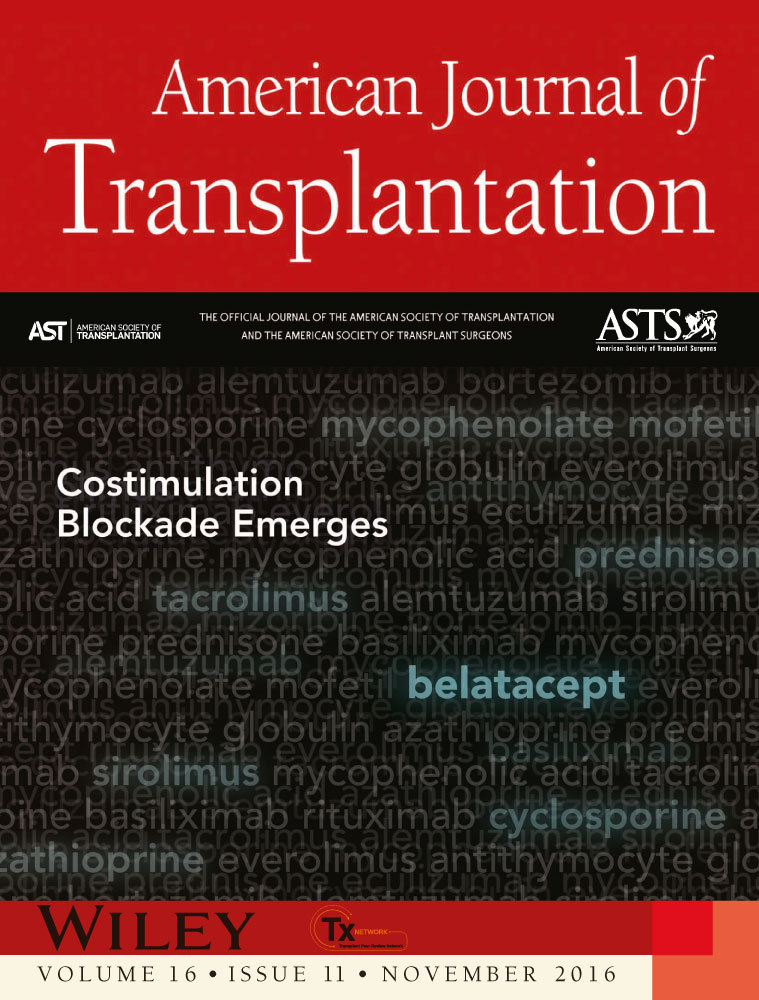Steroid-Responsive Acute Rejection Should Not Be the End Point for Immunosuppressive Trials
Abstract
Development of new immunosuppressive regimens for transplantation has come to a standstill, leading the authors to urge for substantial change of the current regulatory requirements and endpoints for new agent approval.
In 1979, calcineurin inhibitors (CNIs) were introduced clinically as an immunosuppressive option 1. The transplant community finally had a drug powerful enough to control allograft rejection, enabling routine long-term survival. Thirty-five years ago, acute rejection caused graft loss and thus could appropriately be equated with outcome. Although the nephrotoxicity of cyclosporine was recognized, the benefit of CNIs in controlling rejection far out-weighted the nephrotoxicity.
Today, early, steroid-unresponsive acute cellular rejections are uncommon, and when they occur, they are typically responsive to depletional antibody therapy. Historically, an aggressive acute cellular rejection (ACR) could manifest itself acutely as a septic shock. Grafts were frequently lost to acute rejection and patient deaths were commonly seen in all organ recipients. Today that is extremely rare. As an example, at Baylor University Medical Center in our prospective protocolized, locked-down, research database, of 1268 consecutive patients who received a primary liver transplant alone during the past 10 years, 273 patients experienced at least one ACR in the first 3 postoperative months, of which 37 were steroid resistant. There were only three grafts lost from ACR, and none have occurred since 2007. In 344 isolated kidney transplantations in the past 2 years, no grafts were lost to ACR. The lack of effect of T cell–mediated rejection on long-term outcome has been well documented 2. Consequently, although ACR is undesirable, it no longer dictates patient survival, rehabilitation, or quality of life, while immunosuppressive toxicity clearly does.
In extrarenal transplantations, where renal graft rejection cannot be the cause for renal dysfunction, the profound impact of renal toxicity on survival has been well documented, such as a 40% decline in measured glomerular filtration rate (GFR) at 3 months post liver transplantation in previously healthy adults. After 5 years, 1 of 5 liver and 1 of 10 heart recipients has chronic kidney disease 3. Considering CNIs, nephrotoxicity is not the only side effect affecting patients’ lives in the long term. Neurotoxicity is highly prevalent and underrecognized. Physicians can see tremor and patients tell them about their migraines. However, cognitive and emotional changes are more subtle and often avoid attention. One has to specifically ask not only the patient but also their spouse and maybe even the employer. Can the patient perform in their previous position or has he/she been reassigned? Few physicians ask these questions 4. The diabetogenic effect of CNIs has also been an extensively documented independent risk factor for graft loss and patient death.
The substantial benefits from novel immunosuppressive drugs were reported in the recent New England Journal of Medicine article on belatacept, the first report in renal transplantation that shows a continued improvement in GFR over the long term 5; the effect of chronic nephrotoxicity has been abolished. Another reason for the improving renal function with belatacept may be that the presence of donor-specific antibodies (DSAs) at 7 years decreased from 17.8% in the control arm to 1.9% in the study group. The question remains, how will this drastic reduction of DSA production prevent chronic allograft nephropathy/chronic rejection? Today 13 227 patients, 13.3% of the patients on the United Network for Organ Sharing national kidney transplant waiting list, are waiting for a retransplant. The impact of abolishing de novo DSA development after renal transplantation on human suffering and national healthcare cost may be massive.
We believe that new end points for immunosuppressive drug approval are urgently needed. Belatacept can be seen as the prototype of novel drugs that could be derailed by end points that are not as clinically relevant in the current era of immunosuppression. Steroid-resistant ACR, renal function, and neurotoxicity are appropriate end points for studies, and there may be others. However, steroid-responsive rejection, at least for kidney and liver transplantation, has lost its value as a surrogate for patient or graft survival. Indeed, the focus on this has driven an immunosuppressive approach that perhaps accentuates late side effect–related death and eliminates approaches with better aggregate outcomes. We do not treat the transplanted organ but rather the entire patient. Although we are treating the recipient's immune system, organ susceptibility to ACR varies as organs have varying degrees of sensitivity to inflammation. For kidney and liver grafts, steroid-sensitive ACR has little impact on ultimate outcome, and trials should be allowed agnostic to this as a surrogate end point. More fluid movement at least between these two organs should be facilitated in drug approval. Organ-specific dosing and treating algorithms can be developed after generically approving a drug as an immunosuppressive agent.
The current regulations to obtain new drug approval stifle development of novel agents and have driven drug evaluation away from the United States. New drugs are routinely approved years earlier in Europe than in the United States. It delays or prevents new drugs from coming to the market. It makes new drug development substantially more expensive; the cost to bring a new drug to market today is estimated at $3 billion. At present, there are no new immunosuppressive agents in or about to be tested in phase 3 trials in the United States. In the first two decades of this century, only one new drug, belatacept, has been approved for transplantation. Our patients continue to require, and indeed deserve, more.
Disclosure
The authors of this manuscript have no conflicts of interest to disclose as described by the American Journal of Transplantation.




